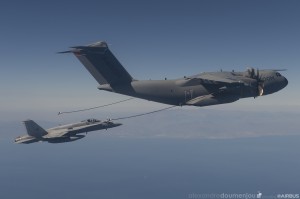2014-08-28 According to a press release today from Airbus Defence and Space:
The Airbus A400M new generation airlifter has performed successfully air-to-air refueling tests with a F/A-18 Hornet fighter.
The tanker test campaign was developed in five flights in which the A400M performed 33 dry contacts and dispensed 18.6 tons of fuel to an F/A-18 Hornet in 35 wet contacts.
With a basic fuel capacity of 50.8 tons, which can be increased by the use of extra cargo hold tanks, the A400M is the most capable tactical tanker in the market.
The standard A400M aircraft has full provisions for Air-to-Air Refueling (AAR) operations already installed as standard and only requires the rapid installation of the optional air-to-air refueling kit to become a tanker.
Designed from the outset to be a dual-role transport and tanker aircraft, the A400M provides air forces with a cost-effective way to acquire an air-to-air refueling capability in addition to a versatile logistic and tactical airlifter.

Earlier, we looked at the potential synergy between the A400M and the A330MRTT in an articled entitled: The A400M Refueling Tests with A330 Tanker: A Task Force for the the 21st Century?
An Airbus Military A400M new generation airlifter has successfully performed simulated refueling contacts with an Airbus Military A330 MRTT Multi Role Tanker Transport.
The A400M made some 30 contacts with the hose and drogue of the A330 MRTT´s Fuselage Refueling Unit (FRU). No fuel was passed in these tests, which consisted of “dry contacts”. The A330 MRTT that took part in the tests is one of the aircraft to be delivered to the UK Royal Air Force, where it is known as Voyager, as part of the Future Strategic Transport Aircraft (FSTA) program.
The FRU is typically used to refuel large aircraft such as the A400M and the tests demonstrated the stability of both aircraft when flying in close formation and when refueling.
Earlier, SLD did an interview with a senior Airbus Military Executive with regard to the possibilities of working the two planes into a joint task force element.
SLD: Could we talk about potential synergies between the A400M and the A330MRTT? The fact that the tanker holds the fuel in its wings, frees up the space inside the aircraft for cargo or passengers.
Conceivably, this could allow flexibility in shaping a tanker-lift task force?
Pablo Quesada: Indeed, but not only in terms of the A400M providing lift and the A330MRTT providing the tanking.
The A400M can be a tanker as well, which can allow an interesting combination of tactical and strategic refueling capabilities over a long distance, which can then operate at low altitudes via the A400M to refuel tactical assets.
In terms of complementarity with the A400M; the A400M is easily configured to refuel a wide range of types from helicopters to fighters, and by taking advantage of the great stability it provides in flight, it is a very effective tanker for lower altitude refueling to the last tactical mile – from a forward operating base, for instance.
In terms of transport, the complementarity of the A400M and A330MRTT is also clear.
The A400M is a superb transport aircraft, which combines tactical and strategic capabilities in a single aircraft.
It could be effectively used in long-range deployment missions either with refueling or with stopovers. But the combination of the operation of the A330MRTT with its true multiple capabilities, plus the tactical capabilities of the A400M will provide a very effective insertion force for either humanitarian or military operations.
Although, either one of them in isolation is also able to fulfill the kind of missions that you are mentioning, the combination of the tactical features of the A400M or the strategic and global reach of the A330 MRTT, could allow one to craft an extremely capable task force.

